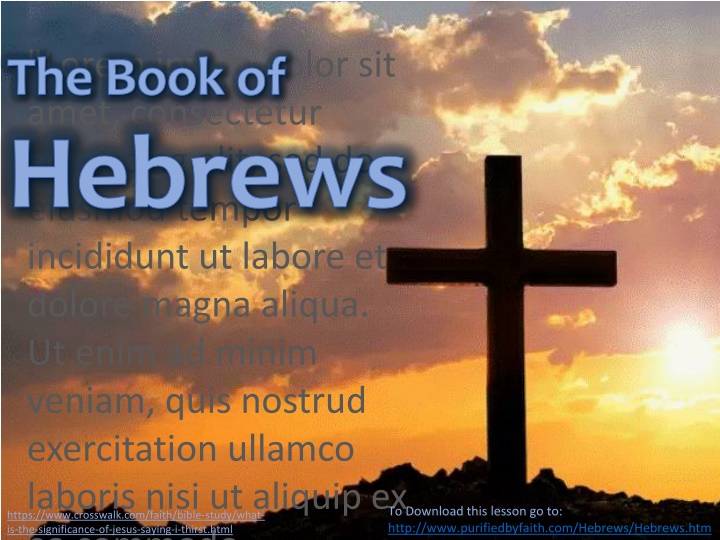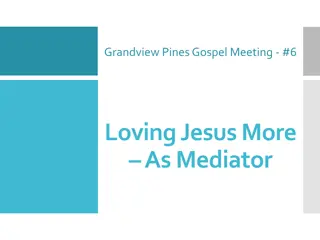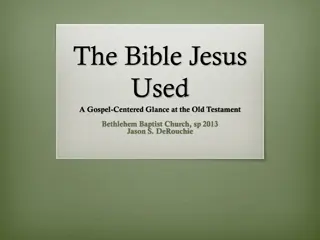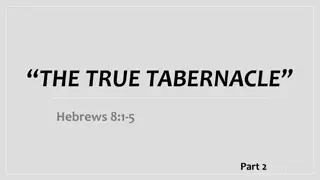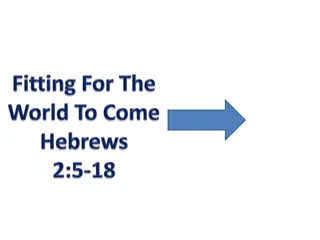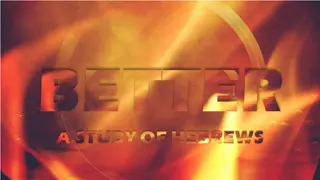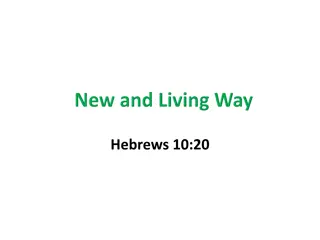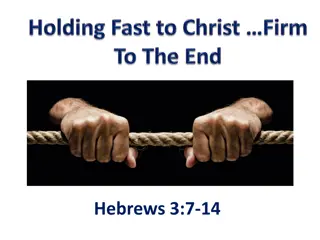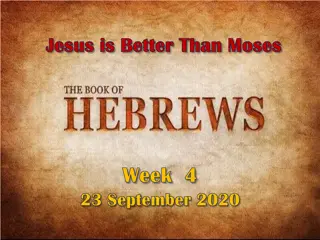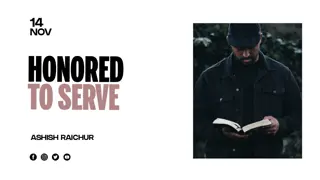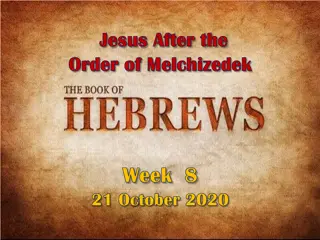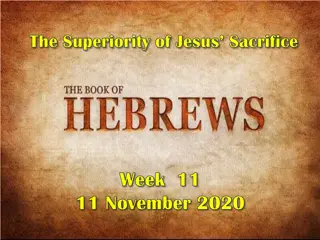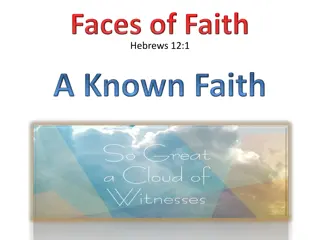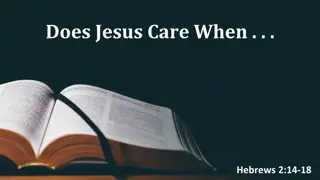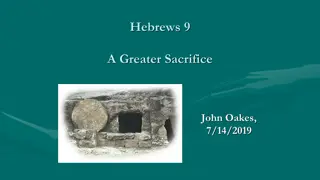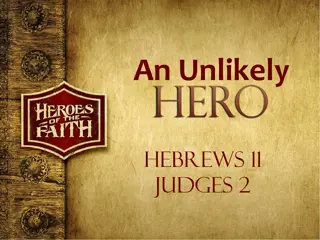Overview of The Book of Hebrews
The provided content offers an in-depth exploration of the Book of Hebrews, highlighting the superiority of Jesus in various aspects such as the Old Testament prophets, angels, Moses, and the priesthood. It delves into the comparisons between the Levitical priesthood and Jesus' priesthood, emphasizing the significance of Jesus' sacrifice and the superiority of the New Covenant. The content also touches on the ministry under the Old Covenant, detailing the regulations, rituals, and symbolism associated with it.
Download Presentation

Please find below an Image/Link to download the presentation.
The content on the website is provided AS IS for your information and personal use only. It may not be sold, licensed, or shared on other websites without obtaining consent from the author.If you encounter any issues during the download, it is possible that the publisher has removed the file from their server.
You are allowed to download the files provided on this website for personal or commercial use, subject to the condition that they are used lawfully. All files are the property of their respective owners.
The content on the website is provided AS IS for your information and personal use only. It may not be sold, licensed, or shared on other websites without obtaining consent from the author.
E N D
Presentation Transcript
"Lorem ipsum dolor sit amet, consectetur adipiscing elit, sed do eiusmod tempor incididunt ut labore et dolore magna aliqua. Ut enim ad minim veniam, quis nostrud exercitation ullamco laboris nisi ut aliquip ex ea commodo The Book of Hebrews To Download this lesson go to: http://www.purifiedbyfaith.com/Hebrews/Hebrews.htm https://www.crosswalk.com/faith/bible-study/what- is-the-significance-of-jesus-saying-i-thirst.html
Outline of Hebrews Jesus is Better I. Jesus Is Better Than the OT Prophets (1:1-4) II. Jesus Is Better Than the Angels (1:5-2:18) III. Jesus Is Better Than Moses (3:1-4:13) IV.Jesus Priesthood Is Better Than the Levitical Priesthood (4:14-10:18)
Outline of Hebrews IV.Jesus Priesthood Is Better Than the Levitical Priesthood (4:14-10:18) A. Jesus Was Appointed By God to Be Our Compassionate But Sinless High Priest (4:14 5:10) B. Jesus Is Better Don t Apostatize (5:11-6:20) C. Jesus Is a Priest After the Order of Melchizedek (7:1-28) D. Jesus Is the Mediator of a New Covenant That Is Far Superior to the Old Covenant (8:1-13) E. Jesus Sacrifice Is Better Than the Temple Sacrifices (9:1-10:18)
Outline of Hebrews A. Jesus Sacrifice Is Better Than the Temple Sacrifices (9:1-10:18) 1. Ministry Under the Old Covenant. (9:1-10) 2. Ministry Under the New Covenant (9:11-14) 3. Further Reflections on the New Covenant (9:15-10:18)
Ministry Under the Old Covenant. (9:1-10) 1 Now even the first covenant had regulations for worship and an earthly place of holiness. 2 For a tent was prepared, the first section, in which were the lampstand and the table and the bread of the Presence. It is called the Holy Place. 3 Behind the second curtain was a second section called the Most Holy Place, 4 having the golden altar of incense and the ark of the covenant covered on all sides with gold, in which was a golden urn holding the manna, and Aaron's staff that budded, and the tablets of the covenant. 5 Above it were the cherubim of glory overshadowing the mercy seat. Of these things we cannot now speak in detail.
Ministry Under the Old Covenant. (9:1-10) 6 These preparations having thus been made, the priests go regularly into the first section, performing their ritual duties, 7 but into the second only the high priest goes, and he but once a year, and not without taking blood, which he offers for himself and for the unintentional sins of the people. 8 By this the Holy Spirit indicates that the way into the holy places is not yet opened as long as the first section is still standing 9 (which is symbolic for the present age). According to this arrangement, gifts and sacrifices are offered that cannot perfect the conscience of the worshiper, 10 but deal only with food and drink and various washings, regulations for the body imposed until the time of reformation.
Introduction In the section we will be looking at today (Heb 9:1-10) the author tells us that three things characterized the old covenant temple worship: Heb 9:1-5 The Need for a Place, Heb 9:6-7 The Need for a Sacrifice or Offering, Heb 9:8-10 The Need for an Approach. DA Carson Lecture on Hebrews
1 Now even the first covenant had regulations for worship and an earthly place of holiness. The author begins by describing the place where the sacrificial worship was carried out under the first covenant (i.e., the old covenant). In describing the old covenant worship structure, the author focuses on the tabernacle of described in the book of Exodus rather than the Jewish temple where the Jews offered sacrifices in his own day. By focusing on the Exodus tabernacle, the author is able to continue his characteristic practice of drawing his material from the Scriptures. Guthrie, George H. Hebrews (The NIV Application Commentary Book 15)
2 For a tent was prepared, the first section, in which were thelampstand and the table and the bread of the Presence. It is called the Holy Place. The description found in 9:2 5 moves from the outer room (or first section as it s called here) of the worship tent (or tabernacle) to the inner room. In the outer room, which is called the Holy Place , the lampstand and the table on which the priests placed the bread of the Presence could be found. The lampstand was made of pure gold, having six flowered branches extending from its sides, three to a side. Seven lamps also were made to sit on the stand, and the stand was placed on the south side of the Holy Place (Exodus 25:31 40; 26:35). Guthrie, George H. Hebrews (The NIV Application Commentary Book 15)
The Lampstand in the Tabernacle https://treasureboxmy.blogspot.com/2015/12/the-lampstand-in-bible.html
2 For a tent was prepared, the first section, in which were the lampstand and the table and the bread of the Presence. It is called the Holy Place. The table , made of acacia wood and overlaid with gold, held the bread of the Presence A literal translation of the Greek phrase here (which is taken from the Septuagint) is the presentation of the loaves . Some translations translate this as showbread (KJV and NKJ) The rendering given by our ESV translation, the bread of the Presence is taken from the phrase used in the Hebrew texts that describe this bread (Ex. 25:30; 35:13; 39:36, etc.) which, translated literally, means bread of the face, in other words, bread set before the face (or presence ) of God This piece of furniture was situated on the north side of the outer room (Ex.26:35). F. F. Bruce. The Epistle to the Hebrews
The Bread of the Presence or Showbread https://www.bibleplaces.com/tabernaclemore/
The Jewish Tabernacle https://www.warrencampdesign.com/hebrews/part2/week21.php
The Jewish Tabernacle https://blogs.bible.org/the-tabernacle-of-moses-gods-heavenly-pattern-for-our-spiritual-transformation-part-iii-the-holy-place/
3 Behind the second curtain was a second section called the Most Holy Place At the west end of the holy place hung a curtain of embroidered linen, suspended under the clasps which coupled together the two sets of linen curtains draped over the tabernacle framework (Ex. 26:31; 36:35ff). This curtain is here called the second curtain to distinguish it from the linen screen through which one entered from the court into the holy place (Ex. 26:36ff; 36:37ff). Beyond the second curtain lay the inner compartment, known as the Most Holy Place . F. F. Bruce. The Epistle to the Hebrews
4 having the golden altar of incense and the ark of the covenant covered on all sides with gold, in which was a golden urn holding the manna, and Aaron's staff that budded, and the tablets of the covenant. The author now begins describing items in (or associated with) the Most Holy Place. There are some problems with the expression translated the golden altar of incense . The Greek word used here (thymiaterion) is a general word that is used to describe something connected with the burning of incense. In the Septuagint this word is always used of a small vessel used for for burning incense know as a censer . And that could be what the author is referring to here. In fact, the KJV translates it as censer in this verse, and a number of commentaries think this is the best way to understand what is being talked about here. Leon Morris The Expositor s Bible Commentary - Hebrews;
4 having the golden altar of incense and the ark of the covenant covered on all sides with gold, in which was a golden urn holding the manna, and Aaron's staff that budded, and the tablets of the covenant. The ordinary censers used by the Jewish priests were made of brass, but we are told by extra-biblical Jewish writers that the censer used by the high priest when he went into the Most Holy Place once a year was made of solid gold: He is to take a censer full of burning coals from the altar before the LORD and two handfuls of finely ground fragrant incense and take them behind the curtain. (Lev 16:12 NIV) It could be that after the high priest had finished, he might have left the censer in the Most Holy Place, so that it would be available when it was needed on the next Day of Atonement. If that is the case, it would explain why the author includes it in a description of the things found in the Most Holy Place. John Brown; Hebrews (Geneva Series)
4 having the golden altar of incense and the ark of the covenant covered on all sides with gold, in which was a golden urn holding the manna, and Aaron's staff that budded, and the tablets of the covenant. Other commentaries argue, as our ESV translation suggests, that this refers to the far more significant altar of incense . The problem with understanding the verse in this way is that the altar of incense is located in the Holy Place, but in this verse the author seems to be describing items located in the Most Holy Place. If the author does have in mind the altar of incense here, it could be that he focusing on the intimate connection between the altar of incense and the Most Holy Place. The altar of incense was located right in front of the veil that separated the Holy Place from the Most Holy place, and in 1 Kings 6:22 we are told that it belonged to the Most Holy Place. Leon Morris The Expositor s Bible Commentary - Hebrews;
The Golden Censer https://graceandtruthdotme2.files.wordpress.com/2014/05/censer.jpg
The Alter of Incense https://messianic-revolution.com/e30-3-the-smoke-from-the-altar-of-incense-symbolizes-the-prayers-of-all-of-gods-people/
4 having the golden altar of incense and the ark of the covenant covered on all sides with gold, in which was a golden urn holding the manna, and Aaron's staff that budded, and the tablets of the covenant. The ark of the covenant , a chest made of acacia wood and overlaid with gold (Exodus 25:10 16), was the most important element of the tabernacle, for above its cover, between the cherubim, God met with Moses (Exodus 25:22). In all ancient literature, Hebrews alone says that in addition to the stone tablets, the jar of manna and Aaron s staff were placed in the ark. The Old Testament suggests these objects were located in the Most Holy Place in front of the ark (e.g., Exodus 16:32 34; Num 17:10 11). Hebrews may be following a strand of rabbinic tradition that presupposed that elements were later placed inside the ark, along with the tablets. Guthrie, George H. Hebrews (The NIV Application Commentary Book 15)
5 Above it were the cherubim of glory overshadowing the mercy seat. Of these things we cannot now speak in detail. The lid of the ark was a golden slab called the mercy seat or place of atonement, viewed by our author as the earthly counterpart of the "throne of grace" to which he has already exhorted his readers to draw near for help in the hour of need (Heb 4:16). The cherubim of glory were two gold figures which overshadowed the mercy seat (Ex. 25:18-22; 37:7-9) and served to support the invisible presence of Israel's God, who is sometimes described as the one who is enthroned on the cherubim (e.g., 1 Sam. 4:4). F. F. Bruce. The Epistle to the Hebrews
The Ark of the Covenant https://www.livescience.com/64932-the-ark-of-the-covenant.html
5 Above it were the cherubim of glory overshadowing the mercy seat. Of these things we cannot now speak in detail. The author ends his description of the tabernacle rather abruptly with the statement, of these things we cannot now speak in detail indicating a reluctance to get sidetracked on matters outside his current focus. Instead, he wishes to move on to discuss the more significant issue of how this structure provided a context for the priests ministry. Guthrie, George H. Hebrews (The NIV Application Commentary Book 15)
6 These preparations having thus been made, the priests go regularly into the first section, performing their ritual duties After describing the tabernacle as the place where the necessary sacrificial worship took place under the old covenant, the author now describes the sacrifice and offerings that needed to be performed by the priests as they ministered in the tabernacle. The priests regularly ministered in the Holy Place (referred to here as the first section ). They were to perform their various duties in the Holy Place, including placing the bread of Presence on the table (Ex. 25:30) which was changed every Sabbath (1 Chron 9:32). Incense was to be offered daily (Ex. 30:8) and the lamps were attended to daily as well (Ex. 27:20). Twice a day sacrifices were to be offered (Ex. 29:38-42) What is particularly emphasized is that they were engaged in this service regularly. Their work was never done and had to be reduplicated every day. Schreiner, Thomas R. Evangelical Biblical Theology Commentary - Hebrews; p. 264
7 but into the second only the high priest goes, and he but once a year, and not without taking blood, which he offers for himself and for the unintentional sins of the people. Every day the priests minister in the Holy Place, but the Most Holy Place is an entirely different matter. Only the high priest can enter the inner sanctuary, and he is not allowed to enter whenever he wishes (Lev 16:2). The Most Holy Place is restricted to once a year on the Day of Atonement (Ex. 30:10; Lev 16:34). Nor does the high priest enter the room boldly. Taking blood (animal sacrifice) is necessary for forgiveness to be secured first (Lev 16:14-15). He offers a bull for a sin offering for a sin offering for himself (Lev 16:3) and two male goats for a sin offering for the people (Lev 16:5). Schreiner, Thomas R. Evangelical Biblical Theology Commentary - Hebrews; p. 264
7 but into the second only the high priest goes, and he but once a year, and not without taking blood, which he offers for himself and for the unintentional sins of the people. The unintentional sins of the people. What does that mean? The Hebrew expression is sins not committed with a high hand. Sins committed with a high hand are sins committed in continuing open defiance against God without any regard for the consequences. For that kind of sin there is no forgiveness in the old covenant or the new. (Num 15:30) An example of this kind of sin in the new covenant would be the apostasy the author warns about in Hebrews 6. DA Carson Lecture on Hebrews
8 By this the Holy Spirit indicates that the way into the holy places is not yet opened as long as the first section [i.e., the tabernacle] is still standing That brings us, then, to the approach to God in old covenant. By this the Holy Spirit indicates that the way into the holy places That is, the way into the very presence of God. is not yet opened as long as the first section [i.e., the tabernacle] is still standing. That is, people couldn t get in and see it. There was a death threat for anybody who even looked in even for the high priest himself if he went in without blood at any time other than on the Day of Atonement! DA Carson Lecture on Hebrews
8 By this the Holy Spirit indicates that the way into the holy places is not yet opened as long as the first section is still standing The Holy Spirit was showing, by this old covenant sacrificial system, that access to the presence of God was severely limited. It had not yet been opened up. As long as the tabernacle was still standing, the tabernacle was not only the means of God meeting with human beings; it was also the means of emphasizing the distance between God and human beings. The law itself functions like that. It emphasizes what the will of God is and shows us that we can t get there. Note: The continuation of the tabernacle does not refer to its remaining in existence, but to its continued validity. Now that Christ has come and sacrificed himself, its viability has ended. DA Carson Lecture on Hebrews
9 This is an illustration for the present time, indicating that the gifts and sacrifices being offered were not able to clear the conscience of the worshiper. (NIV) I have gone with the NIV s translation of this verse as I think it fits better with the context. Limited access to God via the old covenant sacrificial system functions as an illustration to the recipients of this letter. In considering the sacrifices of the old covenant system, they may not truly understood what was being communicated for those living in the present time (i.e., the new covenant age). Such sacrifices were ordained by God for a particular period of salvation history, but a new era has arrived. The gifts and sacrifices offered under the old covenant could not clear the conscience of the worshiper. Those who rely on the law have a continual consciousness of sin, having to continually offer sacrifices for their sin day after day, year after year. There is no final relief under that system. DA Carson Lecture on Hebrews
10 but deal only with food and drink and various washings, regulations for the body imposed until the time of reformation. Furthermore, Old Testament regulations were fundamentally external. They dealt with foods, drinks, and regulations for different kinds of washing and cleansing. In other words they point to a greater washing and cleansing, to truly being washed and cleansed from sin. In the OT, washing and cleansing became a metaphor for true forgiveness of sins. Such external regulations had their place for a certain period of salvation history. They were appropriate during the old covenant, but were intended to cease when the day of fulfillment arrived. Since the time of reformation or better the time of the new order (NIV) has arrived, the old regulations are dismissed, for that which they pointed to has come! Schreiner, Thomas R. Evangelical Biblical Theology Commentary - Hebrews; p. 264
Class Discussion Time https://www.weareteachers.com/moving-beyond-classroom-discussions/
*Class Discussion Time Does looking at the tediousness of the old covenant system of worship give you an appreciation of the access that we now have to God in the new covenant? Concerning the author s comment in Heb 9:5 that We cannot discuss these things in detail now, D.A. Carson says: It behooves us, on the basis of what the author has said, to think through what these other things mean. What that suggests is that we are authorized by the author of Hebrews himself to work out the legitimate biblical typologies even when he himself does not do so. So while we should avoid the really silly typologies of an earlier generation that had the red rope of Rahab referring to the blood of Christ or something like that, yet, on the other hand, we should not be so suspicious of reading the Old Testament in this profoundly typological way that we become too cynical by half. Do you agree with what Carson says here?
